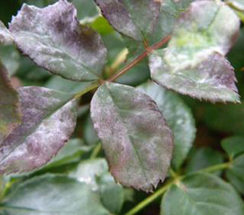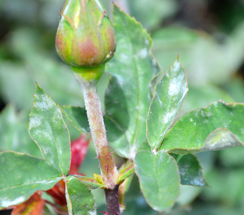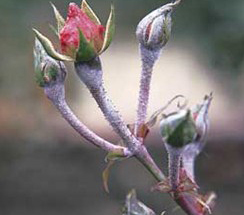Horticultural crops :: Flowers :: Rose
Powdery mildew: Sphaerotheca pannosa
Symptoms:
-
The symptom appears as grayish-white powdery substance on the surfaces of young leaves, shoots and buds.
-
Infected leaves may be distorted, and some leaf drop may occur.
-
Flower buds may fail to open, and those that do may produce poor-quality flowers.
-
It can occur almost anytime during the growing season when temperatures are mild (70 to 80 °F), and the relative humidity is high at night and low during the day.
-
It is most severe in shady areas and during cooler periods
 |
 |
 |
| Powdery mildew on leaves |
Powdery mildew on stalks |
Powdery mildew on buds |
Management:
-
Collection and burning of fallen leaves.
-
Spray with Wettable sulphur 0.3% (or) Carbendazim 0.1% 2-3 sprays at 15 days interval is effective.
-
Sulphur dust at 25 kg/ha.
-
Use of sulphur at higher temperature conditions will be phytotoxic.
Image Source:
http://www.rose-gardening-made-easy.com/images/powdery-mildew-on-roses-21399873.jpg
http://s4.gardenersworld.com/uploads/images/productimage/1226.jpg,
http://www.coltcreek.com/wp-content/uploads/2011/04/roses-014.jpg |
|



